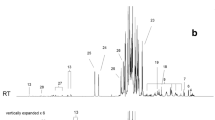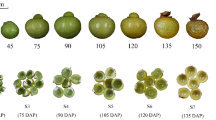Abstract
Highbush blueberries (Vaccinium corymbosum L.) are cultivated worldwide for their fruit with unique taste and potential health benefits. Blueray, Bluecrop, and Spartan are prominent among the various blueberry cultivars. We performed gas chromatography–mass spectrometry (GC–MS)-based metabolic profiling to differentiate the fruits of these three cultivars, and built an optimal partial least squares-discriminant analysis (PLS-DA) model to separate them. Amino acids, fatty acids, organic acids, phenolic compounds, and sugars were identified in the fruits. The optimized PLS-DA model for different cultivars of the fruits was obtained by selecting variables based on a variable importance in the projection (VIP) cut-off value of 1.0. Caffeic acid, aspartic acid, acetic acid, threonolactone, inositol, xylose, glucoside, linolenic acid, mannose, altrose, glycine alanine, and valine were found to be relevant and contributing compounds for differentiating cultivars. In addition, a hierarchical cluster analyses dendrogram pattern was correlated with the PLS-DA. This study suggested that GC–MS-based metabolic profiling coupled with multivariate statistical analysis could be used to differentiate the fruits of three major highbush blueberry cultivars.


Similar content being viewed by others
References
Ballington JR, Mainland CM, Draper AD, Galletta GJ (1982) Bluechip blueberry. HortSci 17:272–273
Barker M, Rayens W (2003) Partial least squares for discrimination. J Chemom 17:166–173
Boches P, Bassil NV, Rowland L (2006) Genetic diversity in the highbush blueberry evaluated with microsatellite markers. J Am Soc Hort Sci 131:674–686
Brevis PA, Bassil NV, Ballington JR, Hancock JF (2008) Impact of wide hybridization on highbush blueberry breeding. J Am Soc Hortic Sci 133:427–437
De Oliveira AC, Valentim IB, Silva CA, Bechara EJH, De Barros MP, Mano CM, Goulart MOF (2009) Total phenolic content and free radical scavenging activities of methanolic extract powders of tropical fruit residues. Food Chem 115:469–475
Eriksson L, Johansson E, Kettaneh-Wold N, Trygg J, Wikström C, Wold S (2006) Multi- and megavariate data analysis, part I: basic principles and applications, 2nd edn. Umetrics, Inc, Umeå, pp 373–374
Halket JM, Waterman D, Przyborowska AM, Patel RKP, Fraser PD, Bramley PM (2004) Chemical derivatization and mass spectral libraries in metabolic profiling by GC/MS and LC/MS/MS. J Exp Bot 56:219–243
Hancock J (2009) Highbush blueberry breeding. Latvian J Agron 12:35–38
Kalt W, Ryan DA, Duy JC, Prior LR, Ehlenfeldt MK, Vander Klet SP (2001) Interspecific variation in anthocyanins, phenolics, and antioxidant capacity among genotypes of highbush and lowbush blueberries (Vaccinium section cyanococcus spp). J Agric Food Chem 49:4761–4767
Kim Y, Hyun SH, Park HE, Choi HK (2012) Metabolic profiling, free-radical scavenging and tyrosinase inhibitory activities of Lemna minor whole plants cultivated in various concentrations of proline and sucrose. Process Biochem 47:62–68
Lee SY, Kim SH, Hyun SH, Suh HW, Hong SJ, Cho BK, Lee CG, Lee H, Choi HK (2014) Fatty acids and global metabolites profiling of Dunaliella tertiolecta by shifting culture conditions to nitrate deficiency and high light at different growth phases. Process Biochem 49:996–1004
Maatta-Riihinen KR, Kamai-Eldin A, Törrönenb AR (2004) Identification and quantification of phenolic compounds in berries of Fragaria and Rubus species (Family Rosaceae). J Agric Food Chem 52:6178–6187
Moore JN, Brown MV, Bordelon BP (1993) Yield and fruit size of ‘Bluecrop’ and ‘Blueray’ highbush blueberries at three plant spacings. HortSci 28:1162–1163
Neto CC (2007) Cranberry and blueberry: evidence for protective effects against cancer and vascular diseases. Mol Nutr Food Res 51:652–664
Ou Z, Schmierer DM, Rades T, Larsen L, McDowell A (2013) Application of an online post-column derivatization HPLC–DPPH assay to detect compounds responsible for antioxidant activity in Sonchus oleraceus L. leaf extracts. J Pharm Pharmacol 65:271–279
Ronald L, Cao G, Martin A, Sofic E, McEwen J, O’Brien C, Lischner N, Ehlenfeldt M, Kalt W, Krewer G, Mainland CM (1998) Antioxidant capacity as influenced by total phenolic and anthocyanin content, maturity, and variety of Vaccinium species. J Agric Food Chem 46:2686–2693
Ryou, Ju HY, Kim JK, Lee SC, Cho IS, Kang TJ (2010) Questions and answers: blueberry cultivation techniques. National Institute of Horticultural and Herbal Science, Suwon, p 11
Sinelli N, Spinardi A, Di Egidio V, Mignani I, Casiraghi E (2008) Evaluation of quality and nutraceutical content of blueberries (Vaccinium corymbosum L.) by near and mid-infrared spectroscopy. Postharvest Biol Technol 50:31–36
Skupień K (2006) Chemical composition of selected cultivars of highbush blueberry fruit (Vaccinium corymbosum L.). Folia Hort 18:47–56
Watanabe J (2006) Blueberry pictorial book. Marumo Publishing Co., LTD, Tokyo, p 23
Acknowledgments
This work was supported by the Chung-Ang University excellent freshman scholarship grants and by the “Cooperative Research Program for Agriculture Science & Technology Development (Project No. PJ008550)” funded by Rural Development Administration.
Author information
Authors and Affiliations
Corresponding authors
Additional information
Da Yeon Kim and So-Hyun Kim contributed equally to this work.
Electronic supplementary material
Below is the link to the electronic supplementary material.
13765_2015_9_MOESM1_ESM.tif
Figure S1. Representative chromatograms of a Blueray, b Bluecrop, C Spartan fruit samples analyzed by gas chromatography–mass spectrometry (GC–MS). (TIFF 2432 kb)
13765_2015_9_MOESM2_ESM.tif
Figure S2. Principal component analysis (PCA) derived score plots of the blueberry fruit cultivars without variable selection. The continuous-line ellipse indicates the 95 % confidence region. (TIFF 71 kb)
13765_2015_9_MOESM3_ESM.tif
Figure S3. Representative mass spectra of the valine (molecular ion at m/z 144). a in sample, b in NIST MS Library, c in Golm metabolome database. (TIFF 57 kb)
13765_2015_9_MOESM4_ESM.tif
Figure S4. Representative mass spectra of the threonolactone (molecular ion at m/z 147). a in sample, b in NIST MS Library, c in Golm metabolome database. (TIFF 57 kb)
13765_2015_9_MOESM5_ESM.tif
Figure S5. Representative mass spectra of the caffeic acid (molecular ion at m/z 396). a in sample, b in NIST MS Library, c in Golm metabolome database. (TIFF 56 kb)
Rights and permissions
About this article
Cite this article
Kim, D.Y., Kim, SH., Ahn, H.M. et al. Differentiation of highbush blueberry (Vaccinium corymbosum L.) fruit cultivars by GC–MS-based metabolic profiling . J Korean Soc Appl Biol Chem 58, 21–28 (2015). https://doi.org/10.1007/s13765-015-0009-y
Received:
Accepted:
Published:
Issue Date:
DOI: https://doi.org/10.1007/s13765-015-0009-y




